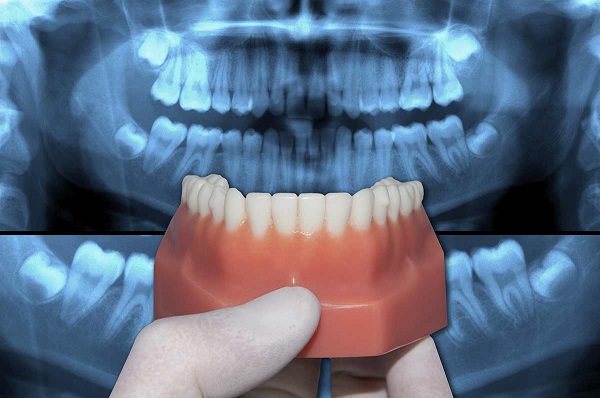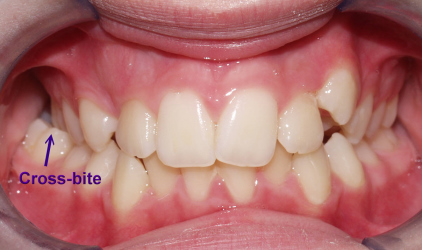Crossbite can cause not only aesthetic problems and the ensuing social and/or psychological anxiety, but can have physical complications as well. While this orthodontic condition is common in children, it can also affect adults. Below, we provide the crossbite definition, we explain the causes and complications of it, and we discuss the possibilities for posterior crossbite treatment.

Posterior Crossbite Definition
Crossbite is the abarrent, or abnormal, meeting of one or more of the maxillary teeth with the mandibular teeth. In layperson terms, a crossbite is a misalignment of the teeth resulting in a failure of them to meet normally when chewing or biting.
Specifically, the deviation from normal occurs as one or more of the upper teeth (maxillar) bite down inside one or more of the lower ones (mandibular). In a posterior crossbite, upper rear teeth close inside the lower rear teeth. Teeth involved in a crossbite assume a position regarded by dentists as too close to the cheek or tongue.
What Causes Posterior Crossbite?
Patients with crossbite may have a family history with the condition. Babies born prematurely may also be more likely to have crossbite. However, certain behaviors and events can also increase the risk of crossbite or other misalignments of the teeth. These include:
- Sucking on thumb or pacifier at age three or beyond
- Bottle feeding for lengthy periods of time
- Cleft lip or cleft palate
- Teeth with irregular impact or shape
- Trauma to teeth
Allergies, tonsils, or adenoids may interfere with the passage of air during breathing and the resulting obstruction may lead to crossbite.
How to Detect Posterior Crossbite?
Facial or oral appearance usually is a noticeable sign of crossbite. Other symptoms implicate the function of teeth and other areas of the body. These include:
- Pain or discomfort in eating, especially chewing and biting
- Jaw or tooth pain
- Lisps and other speech problems
- Mouth breathing rather than nasal breathing
- Intense headaches
If you experience any of these symptoms, a dentist can perform x-rays to determine whether you have a crossbite, including a posterior one.

Posterior Crossbite Complications
Grinding of teeth and abnormal tooth development often accompany crossbite and can result in a face lacking symmetry. This can add to the appearance issues arising from crossbite.
Beyond aesthetics, untreated crossbite can lead to complications in many areas and functions of the body. For those with crossbite, jaw muscles and their nerves undergo stress. This pressure triggers headaches and pain in the neck, jaw, shoulders, and back. Tooth decay arises from crossbite because the misaligned teeth prove difficult to brush and floss. Due to inadequate cleaning, the teeth become a platform for bacteria to infect and undermine tooth structure.
Posterior Crossbite Treatment for Children
Orthodontic appliances, especially for children or teenagers, may promote posterior crossbite correction. These expanders are either affixed to the teeth or palate or are removable. The type will depend upon the amount of correction needed.
Acrylic material forms the structure for the Haas expander. This thermal plastic is used for the palate fitting and holds the bands in the arm. Screws hold the expander into the teeth which need to be adjusted. Due to the width of the coverage of the palate, the alignment can occur with less tipping. In the Hass and other fixed, or bonded, expanders, a special key turns the screws to create the corective force.
The Haas expander is an example of a palatal or maxillary posterior crossbite treatment. Orthodontists will use these particularly on children, whose palates have yet to fully develop.
Posterior Crossbite Treatment in Adults
For adults with posterior crossbite, treatment may be limited because the palate has fully developed.
For an adult that does not require extensive posterior crossbite correction, an orthodontist may recommend a removable expander for nighttime use. These devices normally come in plastic or other flexible material. While the flexibility may work for adults with mild cases of overbite, older children might not benefit because the less rigid material doesn’t apply enough force.
As with the bonded counterparts, the removable expanders rely on a key to turn the screws that move the expander outward. If an adult has a more pronounced or severe case of crossbite, a removable expander likely won’t do the job because of the lack of force created from it.
In that event, the dentist or orthodontist may resort to surgery. One procedure breaks the jaw bone into pieces so that the patient’s mouth or palate can accommodate a custom-made expander of sufficient width and material to apply the necessary force.
Posterior Crossbite Expander Alternatives
If this does not work, the orthodontist may have to extract the tooth or teeth causing the overbite. A tooth extraction in adults can be followed by methods to replace the tooth. These might include a bridge, a partial denture which can be removed, or an implant. In some cases, the professional may immediately prepare a denture and then fit it immediately following the extraction. This involves considerable expense and must be replaced within one year of placement.
For parents, eventually weaning their babies off of pacifiers, thumbs or bottle-feeding can reduce the risk of crossbite. Some incidents may not be avoidable, especially if there is a family history. For younger patients, expanders may correct the posterior crossbite. Adults may have limited measures, especially if the condition is severe.
Please share your experiences in the comments section below if you have ever received posterior crossbite treatment.

Leave a Comment